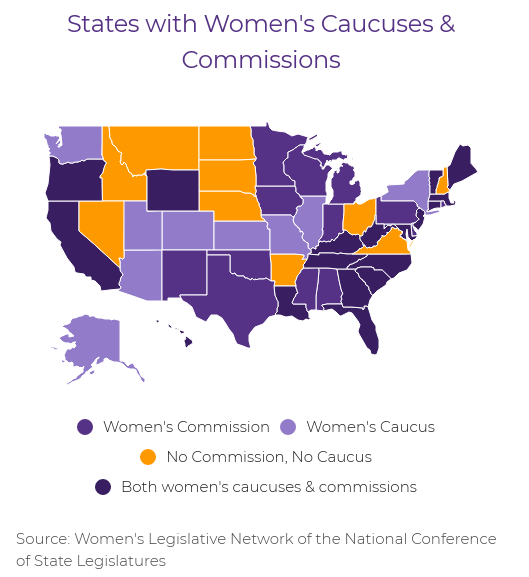City, state and national legislatures must advance their culture and norms, past the ‘old boys clubs’ that still dominate politics, as elected representatives become more diverse in terms of gender, race, ideology and age.
In 1923, suffragist and ERA author Alice Paul wrote, “My hope is that a hundred years from now the world will no longer be a man’s world, but a woman’s and man’s world with each sex participating equally in the control of government.” Ninety-eight years later, women make up less than 30 percent of U.S. elected officials and no woman has served as president. Where did the U.S. go wrong? And how can activists and legislators correct the mistakes made, ensuring women are equally represented in America?
To answer this question, throughout Women’s History Month, Ms. and RepresentWomen are proud to present this series focusing on four steps the U.S. can—and should—take to increase the number of women in elected office and leadership positions:
- Women Run: including gender-inclusive and diverse quotas for races, as well as recruitment and funding targets.
- Women Win: learning from other countries’ electoral systems and strategies which allow women to win at higher rates than they do in the U.S.
- Women Serve: ensuring a living wage and modernized workplace rules like proxy or remote voting, paid family leave and on-site child care.
- Women Lead: creating diversity at the top decision-making levels by appointing gender-balanced and diverse Cabinets and staff.
Get caught up here.
Even as the number of women in elected office grows, American political life has yet to shift from a ‘man’s world’ to a ‘woman’s and man’s world’—as predicted by Alice Paul nearly 100 years ago. The barriers women face do not end once elected, and sheer numeric increases in women’s representation are not enough to eliminate them. In order for women to serve effectively once in office, gender parity is not enough on its own; we must change legislative workplace culture and policy to welcome and retain women leaders.
City, state and national legislatures must advance their culture and norms, past the ‘old boys clubs’ that still dominate politics, as elected representatives become more diverse in terms of gender, race, ideology and age.
Structurally, women face challenges stemming from the antiquated legislation models as part-time, second jobs for influential, wealthy individuals. For many women, especially those with children or caring for other family members, the job’s financial and time burdens are too high to justify traveling long distances and being away from family.
Currently only one state, Alaska, offers state government employees child care services, which legislators must still pay for out of pocket. Despite the increasing use of proxy voting during the pandemic, policies are uneven across states and continue to impact women disproportionately, with Buffy Wicks, a member of the California Assembly, going viral earlier this year after being denied a proxy vote soon after giving birth.
Legislatures should take intentional steps to ensure women can serve effectively in their roles, adopting reforms such as:
- Affordable on-site child care: Working parents, and especially mothers, face a double-burden of both child care and their paid jobs. By providing affordable and on-site child care ensures working parents can effectively serve.
- Telecommuting and/or proxy voting opportunities: Especially important in the time of COVID-19 are established policies which allow elected officials to fully participate in the legislature from home if needed.
- Family friendly schedules: Elected and appointed officials should not have to choose between doing their job to the best of their ability and spending time with their families. Legislatures should schedule votes, meetings and hearings with family obligations and schedules in mind.
- Living wages: the annual salaries for many state and local legislators is not enough to live on, requiring elected officials to either have an additional job which allows for considerable time off, or be independently wealthy. Further research on the gender pay gap is currently being conducted by the National Conference of State Legislators.
Similar steps to ensure a fair and safe workplace for women legislators at the congressional level are already being considered by the Committee on House Administration and the director of oversight and modernization, Aubrey Neal.
At the local level, the city of Sacramento has made headlines by establishing an Office of Diversity and Equity for local government. The body has established strategic initiatives to achieve racial and gender equity in local government, including setting out a five year “Race and Gender Equity Plan” as a framework for all city departments and offices.

While internal process reforms like these are one tactic, 29 states have already taken another promising step with the establishment of bipartisan Women’s Caucuses. Although these groups’ strengths vary, in states with Women’s Caucuses, on average, women make up 32.4 percent of the legislature, compared to the national average of 29.5 percent.
Outside of networking opportunities, these caucuses have established initiatives that improve women’s ability to serve in state legislatures. Many caucuses tackle workplace sexual harassment, and, crucially, women’s caucuses often serve as stepping stones to leadership positions, whether through mentorship or political backing.
Nevada provides a prime example of the impacts of a modernized work culture, not only the number of women entering politics but also their career trajectories once elected. In 2018, Nevada made history as the first State to have a majority of women in its state legislature; before the 2020 election cycle, women held 33 of the state’s 63 legislative seats, for a slim majority of 52.4 percent. This year, Nevada women hold 11 out of 21 seats in the Senate and 27 out of 42 seats in the General Assembly. Currently, women chair five of the ten State Assembly committees, and in the State Senate, are six out of the ten committees chairs.
Local groups fighting for women’s equality and representation have taken on similar roles studying the best practices to ensure women’s fair and active representation in elected bodies. Groups like the Wyoming Women’s Network are working to address the structural barriers women face in local and state politics, marrying much of RepresentWomen’s research with reform packages the Wyoming legislature can adopt to ensure women serve effectively and the needs of women constituents are met.
Congress, state legislatures and local governments must modernize their internal practices and culture so that women legislators can serve and lead effectively. Erratic work schedules, low pay rates, geographic distance, and unfair leadership selection processes serve as a challenge for many women—especially those caring for relatives and managing households. Although these reforms would benefit men and women, these issues disproportionately affect women and will continue barring women from serving.
As women continue their fight for fair and gender balanced political representation, time and effort can not rely on only increasing the number of women running for office and winning. The progress envisioned by suffragist Alice Paul requires not just a radical increase in the number of women running and winning but institutional evolution to ensure once elected, women can effect just as much change and influence as men.
You may also like:





